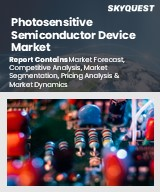
감광성 반도체 디바이스 세계 시장 규모는 2023년 42억 달러, 2024년 44억 1,000만 달러에서 2032년에는 65억 7,000만 달러에 이르고, 예측 기간(2025-2032년) CAGR은 5.1%를 나타낼 전망입니다.
포토다이오드 및 포토트랜지스터를 포함한 광검출기 수요는 스마트폰, 이미지 센서, 보안 시스템 등 수요에 힘입어 급증하고 있으며, 시장의 상당 부분을 차지하고 있습니다. 동시에 태양에너지에 대한 정부의 지원으로 고품질 광전지와 광센서에 대한 수요가 크게 증가하고 있습니다. 그러나 갈륨비소나 실리콘 카바이드와 같은 특수 반도체 재료와 관련된 연구개발비용이 높기 때문에 특히 중소 제조업체에게는 여전히 과제가 남아있습니다. 또한, 제조 폐기물에 대한 엄격한 환경 및 안전 규제는 제조 공정을 복잡하게 만들고, 제품 개발을 지연시키거나 전체 운영 비용을 상승시킬 수 있습니다.
Global Photosensitive Semiconductor Device Market size was valued at USD 4.2 billion in 2023 and is poised to grow from USD 4.41 billion in 2024 to USD 6.57 billion by 2032, growing at a CAGR of 5.1% during the forecast period (2025-2032).
The demand for photodetectors, which encompass photodiodes and phototransistors, has surged, driven by the needs of smartphones, image sensors, and security systems, representing a substantial portion of the market. Concurrently, government support for solar energy initiatives has markedly increased the need for high-quality photovoltaic cells and light sensors. However, challenges persist due to high research and development costs associated with specialty semiconductor materials like gallium arsenide and silicon carbide, particularly for smaller manufacturers. Additionally, stringent environmental and safety regulations concerning production waste complicate manufacturing processes, potentially delaying product development and raising overall operational expenses.
Top-down and bottom-up approaches were used to estimate and validate the size of the Global Photosensitive Semiconductor Device market and to estimate the size of various other dependent submarkets. The research methodology used to estimate the market size includes the following details: The key players in the market were identified through secondary research, and their market shares in the respective regions were determined through primary and secondary research. This entire procedure includes the study of the annual and financial reports of the top market players and extensive interviews for key insights from industry leaders such as CEOs, VPs, directors, and marketing executives. All percentage shares split, and breakdowns were determined using secondary sources and verified through Primary sources. All possible parameters that affect the markets covered in this research study have been accounted for, viewed in extensive detail, verified through primary research, and analyzed to get the final quantitative and qualitative data.
Global Photosensitive Semiconductor Device Market Segments Analysis
Global Photosensitive Semiconductor Device Market is segmented by Device, Application and region. Based on Device, the market is segmented into Photovoltaic cells, Photodiode, Phototransistor and Photoresistor. Based on Application, the market is segmented into Consumer electronics, Optical communication, Imaging & sensing, Renewable energy, Industrial, Automotive and Others. Based on region, the market is segmented into North America, Europe, Asia Pacific, Latin America and Middle East & Africa.
Driver of the Global Photosensitive Semiconductor Device Market
The rising demand for superior imaging capabilities in smartphones, security cameras, wearables, and AR/VR technologies is a key catalyst for growth in the global photosensitive semiconductor device market. Components like photodiodes and phototransistors play a crucial role in these imaging systems, facilitating critical functions such as light detection, object tracking, and gesture recognition. This ongoing innovation within the sensor market and advancements in image capture technologies are propelling the demand for advanced optoelectronic components that respond to light. As original equipment manufacturers (OEMs) continually enhance sensor resolution and speed, the focus on cutting-edge optoelectronic solutions intensifies, further supported by persistent research and development efforts across the consumer electronics landscape.
Restraints in the Global Photosensitive Semiconductor Device Market
The Global Photosensitive Semiconductor Device market faces significant challenges primarily due to the substantial capital investments and the expenses associated with high-cost materials, such as GaAs and InGaAs. The financial burden extends beyond raw materials to include substantial upfront and operational costs linked to constructing and maintaining clean rooms, lithography draw stations, and sophisticated fabrication tools. These financial constraints can hinder the entry of small and medium-sized enterprises into the market, potentially stifling innovation and limiting opportunities, especially in economically developing regions where resources are more constrained. This creates a barrier to market accessibility and technological advancement.
Market Trends of the Global Photosensitive Semiconductor Device Market
The global photosensitive semiconductor device market is experiencing a significant upward trend, driven by the rising integration of photosensitive devices in artificial intelligence (AI) and edge computing applications. This convergence is unlocking new possibilities for high-speed photonic components, which are crucial in enabling real-time data processing with minimal latency across various sectors, including autonomous vehicles, industrial automation, and surveillance systems. The demand for advanced photodiodes and image sensors is propelling innovation in neuromorphic sensors and silicon photonics, prompting both startups and established companies to strategically redirect their research and development efforts and funding toward AI-optimized optical components, thereby accelerating growth and market evolution.